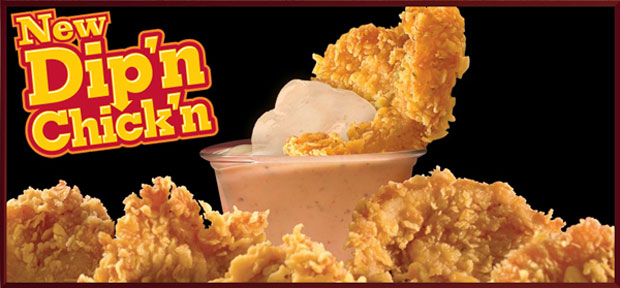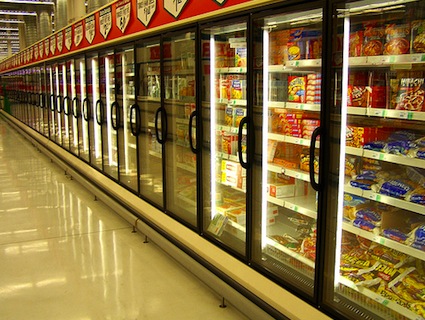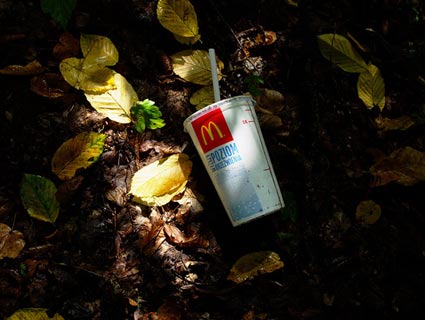
The Beefy Nacho burrito: "crunchy nacho chips, covered in warm nacho cheese sauce, delicious 100% real seasoned beef, and cool reduced-fat sour cream, all wrapped up in a warm flour tortilla for maximum portability"Popeyes
Wednesday’s post on the American diet focused on what people buy at the supermarket (short story: a vast amount of processed food). What do we eat when we eat out? The Wall Street Journal‘s Sara Nassaur brings some data points:
“Americans eat more on the go than anywhere else in the world,” and the trend is growing, says Wade Thoma, vice president of the menu innovation team for McDonald’s U.S.A. Drive-through orders make up around 70% of its sales, he says.
Then there’s this:
Seventeen percent of all meals ordered at restaurants in the U.S. are now eaten in cars, according to NPD Group, a consumer research firm.
The article chronicles the fast food industry’s noble effort to satisfy desire for food on the go. For example, from Popeye’s Louisiana Kitchen comes the “Dip’n Chick’n,” which the company began to sell last year “after market research revealed people were very interested in a fried, boneless chicken snack that could be eaten ‘just like chips and dip,'” the Journal reports. Here are four more fast-food inventions that fall into the eat-in-the-car category:
-
 Popeye’s is also marketing a “Rip’n Chick’n” product that you’re meant to rip into pieces and dip into sauce.
Popeye’s is also marketing a “Rip’n Chick’n” product that you’re meant to rip into pieces and dip into sauce.
-
 McDonalds’ Chicken McBites, this one even more convenient for driving while eating. The McBites come in a “container that fits in a car’s cup holder with a slot for dipping sauce,” the Journal reports.
McDonalds’ Chicken McBites, this one even more convenient for driving while eating. The McBites come in a “container that fits in a car’s cup holder with a slot for dipping sauce,” the Journal reports.
-
 Wendy’s offers this Homestyle Chicken Go Wrap. “Think of it as a wrappetizer.”
Wendy’s offers this Homestyle Chicken Go Wrap. “Think of it as a wrappetizer.”
-
 A recent Taco Bell menu addition is the Beefy Nacho Burrito. “Bite into crunchy nacho chips, covered in warm nacho cheese sauce, delicious 100% real seasoned beef, and cool reduced-fat sour cream, all wrapped up in a warm flour tortilla for maximum portability.”
A recent Taco Bell menu addition is the Beefy Nacho Burrito. “Bite into crunchy nacho chips, covered in warm nacho cheese sauce, delicious 100% real seasoned beef, and cool reduced-fat sour cream, all wrapped up in a warm flour tortilla for maximum portability.”
These novelty products follow a proud tradition of bite-sized chicken snacks that include KFC’s Popcorn Chicken and White Castle’s Chicken Rings, which the Journal describes as “onion ring-shaped chicken.” Apparently, they’re designed to be between-meal snacks. Get this:
At the same time, snacking, especially between lunch and dinner, is more common. In surveys consumers said “they had a craving for something and they wanted some, but they didn’t want a lot,” says Bonnie Riggs, restaurant industry analyst at NPD. Whereas ice cream or chips used to suffice as a snack, people now want something more substantial like a small sandwich, Ms. Riggs says.
Now, I take with a fat pinch of sodium a lot of this business about how the fast food industry is merely satisfying consumer desire. The industry has a fat war chest to help it shape consumer desire—according to the latest numbers I’ve seen, from Yale’s Rudd Center for Food Policy & Obesity, fast food corporations spend upwards of $4 billion per year on marketing. And in tough economic times, fast food companies know how to profitably churn out cheap and enticing food. Sales and profits for both McDonald‘s and Yum Brands—owner of Taco Bell, KFC, and Pizza Hut—are booming.
While the snack trend may not have precisely been created by the fast food industry’s marketing wizards, they certainly have pushed the national snack binge along, for obvious reasons: It helps draw in consumers between and after traditional meal hours. As far back as 2006, Taco Bell contrived something it called “FourthMeal,” which it defined as the late-night meal between dinner and breakfast. Pitching all manner of chicken-chips-and-dip items to be eaten on the road between meals merely reflects the rest of the industry catching up with Taco Bell.
Moreover, while car dining and compulsive snacking and massive expenditures on home convenience foods are no doubt deplorable trends, they are certainly not the only food trends happening in popular food culture. In low-income areas all over the country, from East New York, Brooklyn, to Milwaukee to Detroit, people are organizing community-based food projects explicitly to counteract the ubiquity of corporate fast food. One of that movement’s main leaders, Milwaukee’s Will Allen, even landed on The Colbert Report this week to promote his new book, The Good Food Revolution.
The Colbert Report
Get More: Colbert Report Full Episodes,Political Humor & Satire Blog,Video Archive
Also, whenever I write about fast food, I always like to point out that fast food doesn’t have to be the brutalist crap slung by the likes of McDonald’s and Popeye’s. Workers in cities have relied on some version of fast food for millennia, as I argue in this brief essay from a couple of years ago, and fast food can be the province of locally owned business employing skilled cooks and sourcing from nearby farms. Witness the food truck trend.













